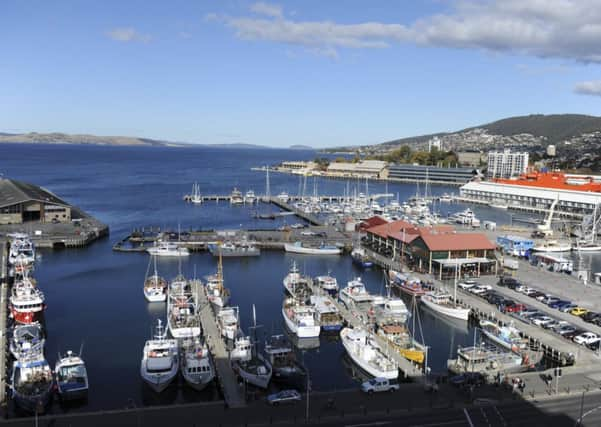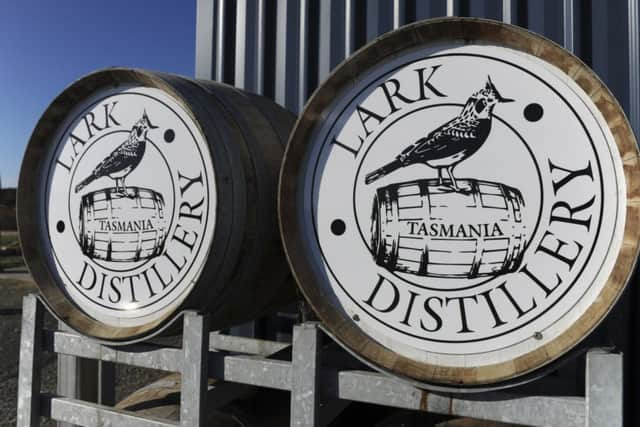Travel: Hobart’s warm Tasmanian welcome


Once a penal settlement for British prisoners, Tasmania is now Australia’s smallest state and, at 160 miles off the southernmost coast of the mainland, it is the last port of call before Antarctica.
Its capital, Hobart, has become a hotbed of modern art, innovative crafts, award-winning whisky and festivals, as well as being the winning post in the Sydney to Hobart Yacht Race.
Advertisement
Hide AdI get my first taste of the city on a cool early morning, with a wee dram at the Lark Distillery Cafe on Davey Street, overlooking the waterfront. The café is the meeting point for Lark’s whisky tours. Hobartian Bill Lark founded his boutique distillery in 1992, when he managed to obtain Tasmania’s first whisky distilling licence in 153 years.


We climb into a minibus for a 45-minute drive to the outskirts of Hobart. Here we find Bill’s small windowless distillery stacked high with hundreds of casks of Tasmanian whisky. We meet the makers and go behind the scenes of the distillation process, sticking our noses into vats and tasting numerous single malts that linger on our taste buds.
I stay at Hobart’s first boutique hostel, the Montacute Boutique Bunkhouse, tucked away at 1 Stowell Avenue in historic Battery Point, the closest hostel (a five-minute walk) to the restaurants, markets, cafés and shops of the city’s famous Salamanca Place and waterfront. Owner Rose Flynn opened the beautifully renovated house in May and it offers inexpensive comfort and style.
A new day and a new experience, this time I take a Segway tour of the waterfront and Salamanca Market with Segway Tasmania. After a practice session, we head off cautiously along the harbour, trying not to ride into the water. The two-wheeled machine is fun and easy to control and I bump up and down footpaths, past the Fish Man selling his daily catch, and along the harbour with its small bobbing fishing boats and icebreakers bound for Antarctica.
Dismounting, I join thousands of people who come from all over Tasmania to browse the Salamanca Market held every Saturday. I find two street blocks packed to overflowing with hundreds of stalls selling food, music, arts and crafts, collectables, clothing and jewellery.
Dinner is at the Crumb Street Kitchen at 144 Harrington Street. The décor is eclectic – all furniture comes from the tip shop and the floor is covered with salvaged Astro Turf. The meaty menu includes signature pulled pork sandwiches, smoked brisket and ribs slowly cooked for 18 hours. Don’t be put off by the queues, the fabulous food is worth the wait and cheap, with prices from £4.50 and £7.
Advertisement
Hide AdThe following morning I take to the skies with Tasmanian Air Adventures. We board the sea plane and take off right on the waterfront for a breathtaking tour over Hobart, the 1,271-metre high Mount Wellington and the River Derwent, with its spectacular surrounding landscape of the southernmost coastline in Australia.
After landing, I take a short walk along the waterfront to the colourful ferry servicing the Museum of Old and New Art (Mona). Opened in January 2011, Mona is Australia’s largest private museum and thousands of people flock to see the exotic and erotic collection every day. Museum owner David Walsh likens his museum to a “subversive adult Disneyland”. I take my time to wander through the three levels of subterranean art space, built into a sandstone cliff face, looking at exciting, breathtaking and jaw-dropping contemporary installations and permanent exhibitions. You can also drive, walk, cycle or take local transport to the museum, where entrance is £11.50 (www.mona.net.au).
Advertisement
Hide AdThe following morning I’m on two wheels again, but this time it’s a mountain bike provided by Wild Bike Tours. We meet at the waterfront for a morning guided ride down Mount Wellington, the highest point in Tasmania.
Our bikes are loaded on to a trailer and we are driven to the top of the mountain. The higher we climb, the worse the weather becomes. Hailstones tumble from the sky, the wind picks up and thick cloud obscures our view.
The conditions improve as we descend the mountain. Halfway down, we trade in the tarmac for a long section of beautiful rainforest with lush vegetation and twisting rocky trails. The thrilling downhill ride from the summit of Mount Wellington to the waterfront is a must, with the three-hour ride costing £45.
In the evening I go in search of dinner, checking Facebook for the location of the trendy TacoTaco food truck, which draws diners out of their dwellings with tantalising £3 tacos. The fillings are locally sourced with free-range, gluten-free, meat, fish and veggie fillings. I find it parked at an abandoned petrol station, where fellow taco pilgrims gather around the vibrantly painted vehicle, perched on old milk crates provided by owner Matt for his fans’ dining comfort.
The following day I drive to Eaglehawk Neck, an hour from Hobart, to join Tasman Island Cruises for a three-hour eco-cruise along the Tasmanian coast. The speedboat leaves the shore and heads into the Southern Ocean, hugging the jagged coastline dotted with blowholes and caves which we take the boat into. We are lucky, as a pod of killer whales surfaces close to our boat as they come close to shore in search of food.
While in Eaglehawk Neck, a visit to Port Arthur Historic Site is essential to understand the history of Tasmania. Port Arthur penal settlement is the most significant of seven locations on the Tasman Peninsula Convict Trail and was once used to confine 12,700 habitual offenders between 1830 and 1877. The scale of the punishments seems so out of proportion to the crimes committed; theft of bread was often the reason for being shipped off from Britain to Tasmania.
Advertisement
Hide AdI head to Hobart’s Salamanca area where popular watering holes include Preachers, with its wide range of Tasmanian wines, ciders and whiskies, and the Grape Bar and Bottleshop. Cargo Bar Pizza Lounge, BarCelona, and Observatory (known as the “O”) have a lively scene and cater to all of your music needs.
Visitors to Australia often overlook historical Hobart. But they should go the extra few miles to experience this unique city, where inspirational and innovative people are making fast, positive changes to a special place.